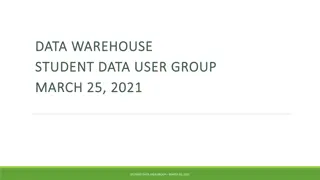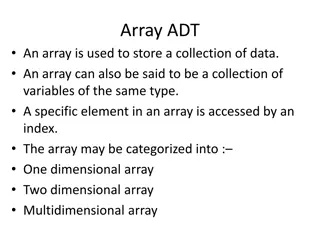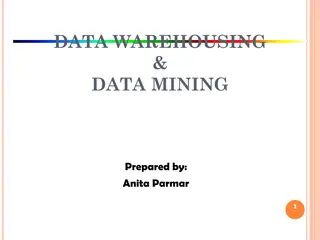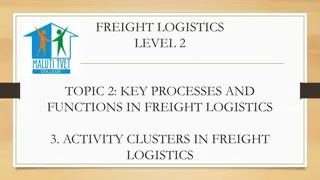Data Warehousing Dimensional Modeling Essentials
This article delves into dimensional modeling, a crucial aspect of data warehousing. Understand the process of designing and implementing dimensional models in relational databases. Explore concepts such as Kimball Lifecycle, requirements analysis, terminology translation, and enterprise bus matrix documentation. Learn how to build a bus matrix and focus on dimensional model design to support your data structures effectively.
Download Presentation

Please find below an Image/Link to download the presentation.
The content on the website is provided AS IS for your information and personal use only. It may not be sold, licensed, or shared on other websites without obtaining consent from the author.If you encounter any issues during the download, it is possible that the publisher has removed the file from their server.
You are allowed to download the files provided on this website for personal or commercial use, subject to the condition that they are used lawfully. All files are the property of their respective owners.
The content on the website is provided AS IS for your information and personal use only. It may not be sold, licensed, or shared on other websites without obtaining consent from the author.
E N D
Presentation Transcript
IST722 Data Warehousing Dimensional Modeling Michael A. Fudge, Jr.
Where are we? Last Week: We covered: Requirements Analysis We learned how to: Turn Business Processes into Dimensional Models This Week: We ll cover Dimensional Modeling We ll learn how to Design and implement dimensional models in relational databases. Detailed High Level
Kimball: From Business Process To Dimensional Models Fact Project Business Processes Fact Program Project Fact Business Processes Project Fact Remote Lab Sessions Login Time in Minutes iSchool DW Program Remote Lab Example:
Terminology Translator: Requirements Analysis vs. Design & Impl. Requirements Analysis Business Process Fact Dimension Dim. Model Business Processes Uses a dimension Design & Implementation Fact Table Column in Fact Table Dimension Table Star Schema Foreign Key
Enterprise Bus Matrix A documentation tool A key deliverable from requirements gathering, the bus matrix documents your business processes, facts and dimensions across all projects in your program.
Group Activity: Build A Bus Matrix TODO: Identify the business processes, facts and dimensions for your group s business processes. Your prof will create an enterprise bus matrix based on the entire program. Using the excel worksheet. STEPS: 1. Identify Business Processes & Type Transaction Single Event Periodic Snapshot Point in Time Accumulating Snapshot Events over Time 2. Identify Facts of the business process Should be Additive, or at least Semi-Additive 3. Identify the dimensions used by the business process
Dimensional Model Design Now that you have dimensional models, its time to focus on how to build the relational structures to support it.
What is Dimensional Modeling A Logical design technique for structuring data with the following objectives: 1.Intuitive: Easy for business users to understand 2.Fast: Excellent query performance Think of a Dimensional Model as a fact table + the dimensions it requires. Dimensional Models are implemented in the Relational DBMS as star schemas. The exist in MOLAP databases as cubes.
Where are the Dimensional Models in the CIF? Red: NOdels Green: YES Models
Components of the Dimensional Model Fact Table A database table of quantifiable performance measurements (facts). Originate from business processes. Has FK s to each of the dimensions. Ex. Sales Amount, Days To Ship, Quantity on Hand. Dimension Table A table of contexts for the facts. Ex. Date/Time, Location, Customer, Product Attribute A characteristic of a dimension. Ex. Product: Name, Category, Department Star Schema Connections among facts and dimensions which define a business process. Ex: Sales, Inventory Management
Star Schema: Relational answer to the DM Dimension Table The Star Schema Is a Relational Database Implementation Of A Dimensional Model Primary Key Fact Table Attribute Foreign Key Fact
Rules of Fact Table Design The Primary Key of your fact table uses the minimum number columns possible & no surrogate keys. (It should be made up of FK s and Degenerate Dimensions) Referential Integrity is a must. Every foreign key in the fact table must have a value. Avoid NULLs in the foreign key by using flags which are special values in place of null. Ex. No Shopper Card in Customer Dimension The granularity of your fact table should be at the lowest, most detailed atomic grain captured by the business process. (discussed last time) Each fact should be Additive, or re-designed to be as additive as possible. Each fact must be of the of the same granularity.
What's Wrong w/This Fact Table of Basketball Player game stats? Stat ID (PK) Player ID Game ID Shot Attempts Shots Made Points Pts Per Shot Shooting Pct 1 Jordan 1 3 2 5 1.667 0.667 2 Jordan 2 7 6 12 1.714 0.583 3 Miller 1 2 0 0 0.000 0.000 4 Miller 2 5 3 9 1.800 0.600 5 Miller 1 2 0 0 0.000 0.000 Can you find the 3 things wrong with the implementation of this fact table?
What's Wrong w/This Fact Table? Non Additive Facts Poor PK Choice Stat ID (PK) Player ID Game ID Shot Attempts Shots Made Points Pts Per Shot Shooting Pct 1 Jordan 1 3 2 5 1.667 0.667 2 Jordan 2 7 6 12 1.714 0.583 3 Miller 1 2 0 0 0.000 0.000 4 Miller 2 5 3 9 1.800 0.600 5 Miller 1 2 0 0 0.000 0.000 Can you find the 3 things wrong with the implementation of this fact table? Poor Choice of FK (or PK)
Rules of Dimension Table Design Verbose attribute values should be as descriptive as possible. Descriptive columns should be easy to tell what the column means. Complete no null / empty values in any of the attributes. Discretely valued one business entity value per row. Quality Assured data is clean and consistent. Should always contain a business key, or legacy PK from source system. Always have a Surrogate Primary Key. You do not introduce a dependency on an external key.
What's Wrong w/This Dimension of Products? Prod Id Prod Name Prod Cat Prod Price Prod Region Code A Apple Fruit $2.00 E B Carrot Veg $1.50 S C Cherries Friut $3.00 S D Lettuce Veg $1.50 E Apple Fruit $2.00 E Can you find the 6 things wrong with the implementation of this dimension?
What's Wrong w/This Dimension? No Surrogate Key Poor Descriptions Prod Id Prod Name Prod Cat Prod Price Prod Reg Code A Apple Fruit $2.00 E Not B Carrot Veg $1.50 S Verbose (What do S & E mean?) C Cherries Friut $3.00 S D Lettuce Veg $1.50 E Apple Fruit $2.00 E Not Discretely Valued Poor Data Quality Incomplete
The Dimension Table Key Surrogate keys (identities, sequences e.g. 1,2,3, ) are used for the primary key constraint. They yield best performance for the Star Schema most efficient joins, smaller indexes in fact table, more rows per block in the fact table They have no dependency on primary key in operational source data. Makes it easier to deal with changes to the source data. Dimension table requires a natural key or business key to identify a unique row. Ex: Customer s email address, Employee s ID number.
Conformed Dimensions These are master or common reference dimensions. Shared across business processes (fact tables) in the DW. Reusable, can be used for drill-across, lower time to develop next star schema. Contain a super-set of attributes required by all fact tables. Two types of Conformed Dimensions: Identical Dimensions exactly the same dimensions (Ex. Dates) Perfect Subset of an existing dimension.
Ex. Conformed Dimensions a Logical View Product Dimension Product key PK Product description SKU number Brand description Class description Department description Sales Fact Table Date key FK Product key FK other FKeys Sales quantity Sales amount Subset Sales Forecast Fact Table Month key FK Brand key FK other FKeys Forecast quantity Forecast amount Brand Dimension Brand key PK Brand description Class description Department description
Date and Time Dimensions Just about every fact table as a date and / or time dimension. This is the most common of conformed dimensions. Usually generated programmatically during the ETL process or imported from a spreadsheet. Acceptable to use PK in the form YYYMMDD In you need time of day, use a separate dimension. Time of day should only be used if there are meaningful textual descriptions of time Ex. Lunch, Dinner, 1st shift, 2ndShift, Etc Elapsed times intervals are facts, not attributes. Ex. Minutes between when order was received and shipped
Ex. Date Dimension Demonstrate Date and Time dimensions on SQL Server
How do you handle Time Zones? Express time in coordinated universal time (UTC) Express in local time, too. Other options: use a single time zone (for example, ET) to express all times in this zone. Call Center Activity Fact Local call date key FK UTC call date key FK Local call time of day FK UTC call time of day FK local call date dimension UTC call date dimension Local call time of day dimension UTC call time of day dimension
Degenerate Dimensions Dimensions we store in the fact table, because there s too many of them for their own a dimension. (For example a 1-1 relationship from fact to dimension) These occur in transaction fact tables that have a parent child (One to Many) structure. Ex. Order Order Detail, Airline Ticket Flights Allow us to drill-through to operational data, in the ODS. Usually ends up as part of the primary key of the fact table.
Slowly Changing Dimensions Dimensional data changes infrequently but when it does you need a strategy for addressing the change. Ex: What happens when a customer has a new address, or an Employee has a name change? 4 Popular strategies Type 1: Overwrite the existing attribute Type 2: Add a new Dimension row Type 3: Add a new Dimension attribute - Mini-Dimension: Add a new Dimension These strategies are not mutually exclusive, and can be combined.
Type 1: Overwrite Appropriate for: correcting mistakes or errors in data changes where historical associations do not matter the old value has no significance If the previous value matters, don t use this strategy. You are rewriting history. Problems will occur with data aggregated on old values. Ex. Employee Name Changes, Corrections, Natural Key Edits.
Type 2: Add New Dimension Row Most popular strategy, as it preserves history Natural key is repeated. Old and new values are stored along with effective dates and indicator of which row is current Product Key Product Descr. Product Code Department Effective Date Expiration Date Current Row 11981 Stapler, Red ST901 Accessories 4/7/2010 9/1/2011 N 20344 Stapler, Red ST901 Supplies 9/2/2011 3/31/2013 N 45393 Stapler, Red ST901 Office Supplies 4/1/2013 12/31/9999 Y The Change
Type 3: Add A New Dimension Attribute Infrequently used, preserves history Useful for Soft changes where users might want to choose between the old and new attribute, or need to access both values for a time. The new value is written to the existing column, the old value is stored in a new column. This way queries do not have to be re-written to access the new attribute. Ex. Redistricting sales territories. Re-charting accounting codes.
Mini-Dimensions: Add a new Dimension If attributes change frequently consider placing them in their own mini-dimensions Most effective when you have banded values, or ranges of discrete values. Customer Dimension Customer key PK Customer ID (Nat. Key) Customer Name Fact Table Customer Key FK Customer Demographics Key FK other FKeys Facts Customer Demographics Dimension Customer Demographics Key PK Customer Age Band Customer Gender Customer Income Band
Role-Playing Dimensions The same physical dimension plays more than one logical dimensional role. This is common among the date dimension Stored in the same physical table, just aliased as a view. Examples: Date: Order Date, Shipping Date, Delivery Date Same Date Address: Ship to, Bill to Same Address Dimension Airport: Arrival, Departure Same Airport Dimension
Junk Dimensions Miscellaneous Flags and text attributes which do not fit within any other dimension. Do Not make a Dimension for each one. Instead place them in their own Junk dimension Invoice Indicator Id Payment Terms Order Mode Ship Mode 1 Net 10 Web Freight Don t Create a Row in your Junk Dimension Until You Need It in a Fact 2 Net 10 Web Air 3 Net 10 Fax Freight 4 Net 10 Fax Air 5 Net 10 Phone Freight 6 Net 10 Phone Air 7 Net 15 Web Freight 8 Net 15 Web Air
Snowflake & Outrigger Dimensions When the redundant attributes are moved to a separate table to eliminate redundancy we get a snowflaked dimension. Product Size Dimension Product Size Key PK Product Size (S,M,L) Product Size Fee Product Dimension Product Key FK Product Name Product Size Key FK Pros: Data is back in 3NF, saves space Cons: More complex for users, decreased performance. Sometimes this is desirable when there are a significant number of attributes in the outrigger dimension. These are the exception not the rule!
Hierarchies in Dimensions Fixed hierarchies Simply de-normalize as attributes Ex. Product: Department -> Type Variable-depth hierarchies - implement with a bridge table (used to resolve M-M relationships) Should be used only when absolutely necessary Negatively affects usability Decreases performance Fact Table Date Key FK Customer Key FK More Foreign Keys Facts . Customer Hierarchy Bridge Parent Customer Key PK,FK Subsidiary Cust. Key PK,FK # Levels from Parent Bottom Flag Top Flag Customer Dimension Customer Key PK Customer Name .
Multi-Valued Dimensions Almost all Fact-Dimension relationships are M-1 Sometimes there s a M-M relationship between fact and Dimension. The Weighing factor is between 0 and 1 and should add up to 1 for each unique group key. Health Care Billing Fact Billing Date Key FK Patient Key FK Diagnosis Group Key FK Bill Amount More Facts . Diagnosis Dimension Diagnosis Key PK ICD-9 Code Diagnosis Description . Diagnosis Group Bridge Diagnosis Group Key PK,FK Diagnosis Key PK,FK Weighing Factor
Check yourself: What Kind of Dimension? Conformed? Degenerate? Slowly Changing? & Type? Role Playing? Junk? Outrigger? M-M (Bridge)? 1. Customers (for orders and sales leads) 2. The various classrooms on a college campus? 3. Items on a restraint menu? 4. Parts required to repair an automobile as part of a service record? 5. The instructors who teach a college class?
Recall 3 Types of Fact Tables grain 1. Events or Transactions (single event) 2. Workflows a.k.a. Accumulating Snapshots (Events over Time) 3. Points in time a.k.a Periodic Snapshots (point in time) Transaction Accumulating Snapshot Periodic Snapshot
Facts of Different Granularity == NO A single fact table cannot have facts with different levels of granularity All measurements must be in the same level of details Example: Measurements are captured for each line order except for the shipping charge which is for the entire order Solutions: Allocating higher level facts to a lower granularity (split shipping charge among each item) Create two separate fact tables (Orders fact & Line Order fact)
Facts: Multiple currencies / Units of Measure Measurements are provided in a local currency Measurements should be converted to a standardized currency or else conversion rates must be stored Similarly, in case of multiple units of measure, conversions to all different units of measure should be provided Ex. Items received are by the box (12 in a box =Received unit factor) Received Price = Received unit factor * unit price
Fact less Fact tables Business processes that do not generate quantifiable measurements Ex: Student attendance, College adminssions Can be easily converted into traditional fact tables by adding an attribute Count, which is always equal to 1. Consider adding facts for when the event did not happen Helps to perform aggregations Ex: Attendance % present or absent versus class size.
Consolidated fact tables Fact tables populated from different sources may consolidated into single fact table Level of granularity must be the same Measurements are listed side-by-side Ex. by combining forecast and actual sales amounts, a forecast/actual sales variance amount can be easily calculated and stored Sales & Forecast Fact Date Key FK Customer Key FK Region Key FK Actual Sales $ Forecast Sales $ Sales Variance $ Sales Fact Date Key FK Customer Key FK Region Key FK Actual Sales $ Forecast Fact Date Key FK Customer Key FK Region Key FK Forecast Sales $
Finally: Dos and Don'ts of DM Do not take a report centric approach Reuse your dimensional models for multiple reports Dimensional models should not be departmentally bound. Reuse your dimensional models for multiple departments Create dimensional models with the finest level of granularity. This will be the most flexible and scalable option. Use Conformed dimensions Helps with integration efforts Simplifies the process of creating the next data mart.
IST722 Data Warehousing Dimensional Modeling Michael A. Fudge, Jr.























